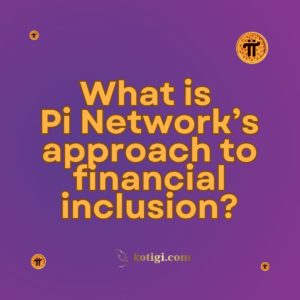
Pi Network has intrigued millions with its promise of a new, accessible cryptocurrency that can be mined directly from smartphones. But a question that often arises is: Will Pi ever be sold? This question touches on Pi’s future prospects, its current market status, and what needs to happen for Pi coins to be sold on exchanges. In this post, we’ll explore the current state of Pi Network, its journey towards becoming a tradable asset, and what it means for its users and investors.
Understanding the Current Status of Pi Network
1. Pi Network Overview
Pi Network is a digital currency project that allows users to mine Pi coins using their mobile phones. It was designed to be user-friendly, providing an easy entry point for those new to cryptocurrency. Despite its growing user base, Pi Network is still evolving and has not yet reached full functionality as a cryptocurrency.
2. Pi’s Development Phases
Pi Network is progressing through several key phases:
- Testnet: The network is currently operating in a testing phase where developers and users can test functionalities without real-world implications.
- Mainnet: The transition to the Mainnet will mark the official launch of Pi’s decentralized blockchain, where Pi coins will have actual value and can be traded.
The Path to Being Sold: Key Milestones
1. Transition to the Mainnet
For Pi to be sold, it must first transition from its Testnet to the Mainnet. This transition is crucial because the Mainnet will enable Pi to operate on a fully decentralized blockchain, allowing it to be listed on cryptocurrency exchanges. Without this step, Pi coins will remain as digital tokens with no market value.
2. Listing on Cryptocurrency Exchanges
Once Pi moves to the Mainnet, the next step is listing on cryptocurrency exchanges. Exchanges are platforms where cryptocurrencies can be bought, sold, and traded. Pi Network’s development team has indicated that Pi coins will be listed on exchanges once the Mainnet is live. This will allow users to convert their Pi coins into other cryptocurrencies or fiat money.
3. Regulatory Compliance
Before Pi can be sold or traded, it must comply with various regulatory requirements. This includes ensuring that the coin adheres to legal standards for digital currencies and passing necessary regulatory approvals. Regulatory compliance is crucial for ensuring that Pi can be traded globally and is not restricted by legal barriers.
Will Pi Ever Be Sold? Analyzing the Possibilities
1. Market Adoption and Value
The potential for Pi to be sold depends on its market adoption and value. For Pi to be a successful and tradable asset, it must demonstrate real utility and gain traction among users and investors. This involves creating a functional ecosystem where Pi coins can be used for transactions, services, and other real-world applications.
2. User Base and Community Support
A strong and active user base can drive the demand for a cryptocurrency. Pi Network has a growing community with millions of users, which is a positive indicator. However, the success of Pi as a tradable asset will also depend on the community’s engagement and the overall development of the network’s ecosystem.
3. Technical and Developmental Progress
The transition to the Mainnet and the development of a secure and functional blockchain are critical. Pi Network’s technical team must address any challenges and ensure that the Mainnet operates smoothly. Successful implementation of the Mainnet will pave the way for Pi coins to be sold and traded.
Comparisons with Established Cryptocurrencies
1. Pi vs. Bitcoin
Bitcoin, as the first and most well-known cryptocurrency, has established itself as a tradable and valuable asset. It operates on a secure and decentralized blockchain, and its coins are actively traded on numerous exchanges. Pi, on the other hand, is still in development and has not yet achieved the level of decentralization or market presence that Bitcoin has.
2. Pi vs. Ethereum
Ethereum is another well-established cryptocurrency that operates on a decentralized blockchain and supports smart contracts and decentralized applications (dApps). Pi aims to build a similar ecosystem but is still working towards achieving these milestones. Ethereum’s success provides a framework for what Pi could potentially achieve but also highlights the challenges Pi faces in becoming a tradable asset.
Potential Challenges and Opportunities
1. Building a Functional Ecosystem
One of the key challenges for Pi Network is building a functional and thriving ecosystem. This involves developing partnerships, creating use cases for Pi coins, and ensuring that the coin can be used for a variety of transactions. A successful ecosystem will enhance Pi’s value and make it more attractive to traders and investors.
2. Regulatory and Legal Issues
Navigating the regulatory landscape is another challenge. Pi Network must ensure that it meets all legal requirements for digital currencies and that it operates within the boundaries of international regulations. Addressing these issues proactively will help Pi gain legitimacy and pave the way for its coins to be traded.
Conclusion
The question of whether Pi will ever be sold hinges on several critical factors, including its transition to the Mainnet, market adoption, regulatory compliance, and the development of a functional ecosystem. While Pi Network has made significant strides and boasts a large user base, it must overcome several hurdles before its coins can be sold or traded. As Pi continues to evolve and work towards these goals, the potential for it to become a tradable and valuable asset remains promising but is not yet realized.
Will Pi ever be sold?
Pi coins cannot currently be sold as they are not yet listed on any exchanges and do not have market value. However, once Pi Network transitions to its Mainnet and meets regulatory requirements, Pi coins will be listed on cryptocurrency exchanges, allowing them to be sold and traded.
Key Takeaways
- Building a robust ecosystem and achieving market adoption are key to Pi’s future success as a tradable asset.
- Pi Network is still in its Testnet phase, and its coins cannot currently be sold or traded.
- The transition to the Mainnet is crucial for Pi to become a fully operational cryptocurrency with market value.
- Pi coins will be listed on exchanges once the Mainnet is live, allowing them to be sold and traded.
- Regulatory compliance is essential for Pi to be legally traded and accepted in the global market.





